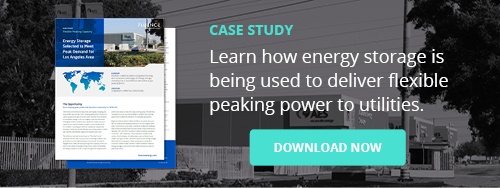Full Steam Ahead
We’re not yet halfway through the year and it is already shaping up to be an inflection point for the U.S. energy storage industry. We’re building on exponential growth – ESA and Wood Mackenzie’s Q1 2021 Energy Storage Monitor showed there was more battery capacity installed during 2020 than during the entire seven years prior – reinforcing the U.S.’s position as a leader in global energy storage deployment. This growth happened despite the challenges presented by COVID - companies across our industry have won contracts, delivered projects, and even built factories throughout the pandemic. We are continuing to expand rapidly to match demand for the capabilities provided by energy storage technologies. The value of storage is increasingly recognized in regional markets today, and system planners and operators now regularly include it as a resource in planning for our shared clean energy future.
Recent policy developments have upped the ante for energy storage, including President Biden’s American Jobs Plan, a return to carbon reduction commitments, the House’s GREEN Act, and Senator Wyden’s Clean Energy for America Act. All these policies call out energy storage as a critical technology, not only for a more sustainable and resilient future, but also as an engine of economic growth, job creation, and U.S. technological leadership.
The U.S. Energy Storage Association (ESA) is going full steam ahead in support of these policy initiatives. I’m privileged to serve as Chairman of ESA’s board of directors at an exciting time for the industry and to work with the stellar team there to advance policies that support the entire energy storage industry and our country’s long-term economic and environmental success.
Passing the Storage ITC: Ensuring Policy Keeps Pace
One of ESA’s top priorities is securing a federal investment tax credit (ITC) for stand-alone energy storage projects. Stand-alone energy storage provides significant benefits to electric grids across the United States, such as the recently commissioned AES Alamitos energy storage project in Long Beach that is providing peak capacity to Southern California during times of need. Electrons are electrons, and grid capabilities are grid capabilities no matter where they are located. Whether co-locating storage and renewables or deploying them at separate locations under a single grid operator, the power system benefits either way.
This is truly a bipartisan issue. An ITC for stand-alone energy storage would support good U.S. jobs and economic growth. President Biden has tied climate and clean energy investment to the creation of good, local jobs, and for good reason. The Solar Jobs Census estimates we will need to fill nearly 1 million solar jobs by 2035 to reach 100% clean energy targets. ESA has estimated that 200,000 energy storage jobs could be created through 2030 if we can build the 100 GW of new storage needed to support that solar build out, as well as wind.
Creating Jobs, Bolstering Resilience & Building a Domestic Supply Chain
My company, Fluence, is actively hiring for dozens of positions in the U.S. (if you want to help change the world, come join us!). And that’s just one company – the U.S. energy storage community encompasses hundreds of businesses ranging from battery OEMs and technology providers to integrators, IPPs and developers. The Wood MacKenzie ESA report also considers the economic impact of energy storage, estimating that energy storage in the U.S. will be a $7.6 billion annual market by 2025.
But we need policies in place to help us get there. Beyond driving economic development, an ITC would help strengthen the electric grid in the face of increasingly frequent and severe weather events. Energy storage stabilizes grids and makes them more flexible, responsive, and resilient, which is critical for keeping power on for consumers during uncertain weather. Most importantly, an ITC for storage will enable our clean energy transition, while also lowering costs for consumers and increasing the reliability of the electric grid. (Side note: the addition of storage capabilities enhances reliability and resiliency in every commodity – perishable goods, transportation, data, water, etc.)
Another priority issue ESA is tackling is punitive tariffs on critical energy storage system components. These tariffs impose additional costs on lithium-ion battery cells and modules procured from China by U.S. companies. The additional cost of the tariffs hampers energy storage deployment in the U.S. by artificially inflating the overall total cost of ownership, and it’s costing U.S. energy storage companies money that could otherwise be spent supporting U.S. economic growth.
The domestic supply chain for batteries is evolving, thanks to some promising early proposals from the Department of Energy. Private sector investment is already beginning to flow into the U.S. to develop a strong local supply chain. I believe that the U.S. will have its own robust battery manufacturing capacity and supply chain in the very near future. However, such capabilities don’t exist here today. Deploying energy storage at scale is not only critical to harnessing the full potential of affordable renewable energy across the country to meet climate goals, but also is one of the best ways to bring manufacturing capacity to the U.S.—robust domestic demand is a prerequisite for standing up a U.S. battery supply chain. Further delay in addressing the tariff issue means U.S. consumers will continue to pay more for this technology while dampening deployment, and that is not sustainable long-term.
Unlocking Exponential Economic Growth
The energy storage industry has grown dramatically without federal policy support based primarily on the demand and economic merits of the market applications of the technology. Imagine how many more jobs we could create and how much more renewable energy we could deploy with federal policies designed to build U.S. manufacturing capability and enable this uniquely flexible asset to participate at its full potential in electricity markets.
We look forward to working closely with the Biden Administration and members of Congress from both parties to enact a stand-alone storage ITC. By recognizing the full benefits of energy storage, we can deliver more cost-effective electricity to U.S. consumers, more resilient electric grid infrastructure, and a faster transition to 100% clean energy.

















